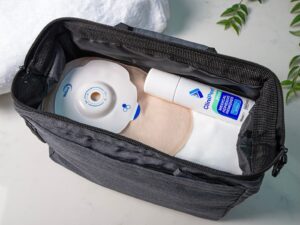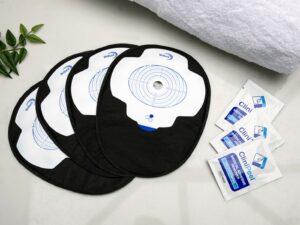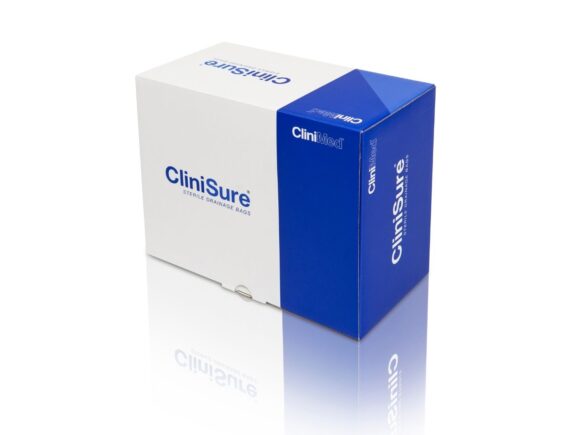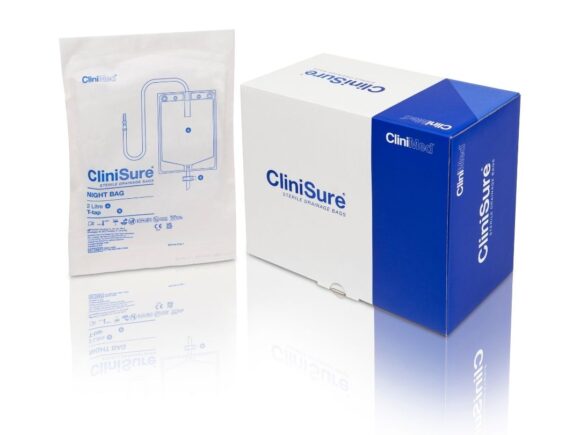Catheter bags are a key part of managing continence when using a urinary catheter. They come in a range of types, sizes, and configurations to support comfort, discretion, and independence in your daily life.
What is a catheter leg bag?
Catheter bags, also known as urine drainage bags, are essential items in managing urinary incontinence and helping you gain independence when using an indwelling catheter or urinary sheath.
Catheter bags are designed to be worn on the body, either around the thigh or calf, or around the waist. In some circumstances catheter bags may be hung from a wheelchair, bed or nightstand. They provide a bag to store urine, an outlet tube for emptying the bag, typically with a lever or tap to open the outlet. They will also have a tube for them to connect to your appliance.
Additional features to look out for when choosing a drainage bag are:
- Length of tube – short or long, depending on where you intend to wear the bag.
- Belt loops – look for soft ones which won’t dig into your skin.
- Volume guide on the bag – this shows how full the bag is, so you know when to empty it.
- Reinforced eyelets – these are really useful if you intend to hang the bag on a nightstand or similar.
- Tap style – T-tap and Lever tap are the most common and these can help if you struggle with dexterity issues.
- Non-return valve – these are important in stopping any urine going back into the appliance and potentially causing infections or UTIs.
How to change a catheter bag
Correctly applying or changing your catheter bag is essential to ensure comfort and avoid the risk of any leaks or blockages. Follow these steps to help you change a catheter bag safely and hygienically:
- Gather the supplies you’ll need (a new bag, sterile wipes, retaining straps, medical tube holder) and place them within easy reach.
- Empty your current bag.
- Wash and dry your hands thoroughly.
- Disconnect the old bag carefully.
- Clean the connector with a sterile wipe.
- Attach the new bag securely using the standard straps if some come with the drainage bag, or new straps, such as CliniSure retaining straps.
- If applicable, fix the tubing using a medical tube holder, such as CliniFix.
- Dispose of the used bag in an appropriate place.
- Wash and dry your hands once more.
Before you attach the bag to your leg or stand make sure the drainage tap is fully closed.
For indwelling catheter users – only a sterile drainage bag should be connected directly to the catheter.
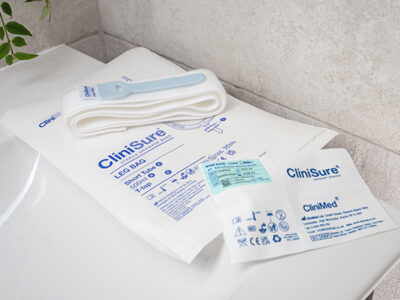
Where and how to attach a catheter bag
Begin by considering where you’d like to place the bag. A urine drainage bag needs to be placed lower than the appliance you use and your bladder to allow the urine to correctly drain.
Common placement is on the leg, this could be around the thigh or calf. Consider things like the clothing you’ll wear, the activities you do and the ease of monitoring and draining the bag when worn there.
Once you know the location you’d like to wear the bag and chosen a product with the correct length of tubing, thread the elasticated straps through the slots on the top and bottom of the bag. Wrap the straps around your leg fastening them when they are tight enough to hold the bag in place but not tight enough to cause discomfort. At this point try and move a little bit in a way that is typical for you to make sure that the tube doesn’t pull at your catheter or sheath.
If you are experiencing discomfort, such as snagging or pulling the device, adjust the placement so you have more excess tube from your appliance to the drainage bag. If you’re worried about the tubing getting caught you can use a securement device, such as CliniFix to hold the tube in place.
Don’t attempt to cut the tubing or adjust the fit this way. Some catheter bags do have adjustable tubing, but many are designed in common lengths and intended to remain sterile. If you’re unsure consult the manufacturer or your healthcare provider.

How to empty a catheter bag and can they be reused?
A common question asked by those new to urine drainage bags is can they be reused? The answer is no, but sterile bags like the CliniSure Sterile Leg Drainage Bags can be used continuously for 5–7 days before being changed, providing the closed system remains unbroken. CliniSure Sterile Night Drainage Bags can also be used continuously for 5–7 days before being changed, however CliniSure Non-Sterile Night Drainage Bags are designed to be used only once.
Do I need to clean my drainage bag?
No, wherever possible a closed, sterile, continuous urine drainage system should be used as per NICE guidelines, and these do not need to be cleaned after emptying. A non-sterile bag is typically single use and should be disposed of.
How to empty your catheter leg bag
Your healthcare provider should provide some guidance on how frequently to empty your leg bag. Typically, every 2-4 hours or when the bag is two-thirds full is common. Make sure you have a container to drain the bag in, and paper towels or wet wipes.
- Wash your hands with soap and water, rinsing thoroughly before ensuring they are dry, or use an alcohol-based hand sanitiser.
- Release the straps holding your bag in place and hold the drainage tap over the toilet. Make sure that you keep the bag below your hip to help it drain.
- Open the drainage tap and let the urine drain into the toilet (or container) but do not let the tubing or spout touch anything.
- Once empty clean the drainage tap before closing it.
- Wash and dry your hands then strap the bag back into place.
Catheter bags have a lever tap or a t-tap which open in slightly different ways. If you’re new to using a catheter bag or have recently switched to a different brand make sure you familiarise yourself with the type of tap the bag you use has to make emptying easier.
How often should I change my catheter bag?
As previously mentioned, most leg bags which are sterile can be used continuously for 5-7 days and non-sterile bags, typically for night-time are a one-time use product.
Whether you use a non-sterile or sterile catheter bag can be a matter of personal comfort or lifestyle but there may be other factors that affect your choice. For example, if you have an indwelling catheter, you should only use sterile catheter bags to connect directly to your catheter to minimise the risk of infection. A non-sterile night bag can be connected to a leg bag overnight.
You should always follow the recommendations of healthcare professionals and the instructions provided by the product manufacturer.
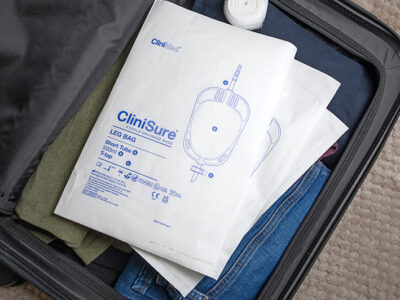
What are night drainage bags?
Night bags are designed to offer greater capacity and therefore comfort while you sleep. As they can store a larger volume of urine than a leg bag, they can help you avoid having to get up during the night to empty your bag.
The night bag can connect either to your leg bag or directly to your catheter or sheath. It has longer tubing than a leg bag giving you extra flexibility and to allow for movement in your sleep.
You can use a night bag stand to help safeguard against spillages and kinks forming in the tube. In the morning (depending on whether you connected the night bag to your leg bag or directly to your catheter or sheath) you can simply disconnect the night bag.

Our Catheter Bag Range and Accessories
Now you know all there is to know to begin your journey using a urine drainage bag why not explore our range of bags and accessories and request a free sample. Don’t forget that SecuriCare, our free 5 star home delivery service can provide all continence products from any brand direct to your door. There’s also our CliniMed careline, on-hand to provide any advice you might need about products or your care routine.
Get Support
Need help choosing the right product or managing your continence routine?
